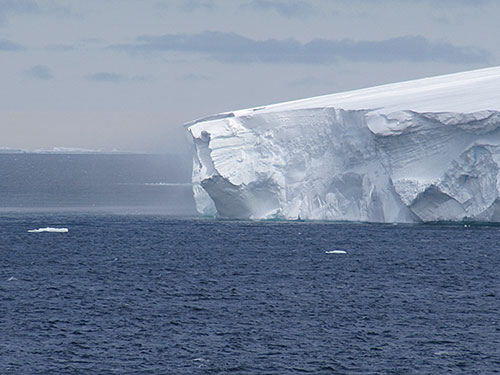Antarctica
The Ancients surmised the existence of the southern Antarctic, as a balance for the northern Arctic. If they found it, what would it look like? How would they travel there? Who would have attempted the journey?
Antarctica is larger than Europe, larger than Australia and larger than the USA. It is surrounded by stormy Oceans. Seasonally, the ocean ice of Antarctica varies from 2.6 million square miles in Summer (December, January, February) to 18 million square miles in Winter (June, July, August), so is accessible only in the Southern Summer.
information about the Earth’s climate at various times in the past. Ice shelves act to hold
The Antarctic Continent is a frozen desert. It’s the coldest, driest, and windiest place on Earth. At an average elevation higher that other continents (at 2300m) there are parts that are as high as 4000m, which results in even colder temperatures. Antarctica has 90 per cent of the Earth’s ice and 80 % of its fresh water. Only 2% of land is exposed. The ice sheet contains approximately 7 million cubic miles (30 million cu km) of ice,
Centered asymmetrically around the South Pole, Antarctica is divided in two by the Transantarctic Mountains close to the neck between the Ross Sea and the Weddell Sea. The portion west of the Weddell Sea and east of the Ross Sea is called West Antarctica and the remainder East Antarctica, because they roughly correspond to the Western and Eastern Hemispheres relative to the Greenwich meridian.
Antarctica is volcanic in nature. There are plenty of granite boulders, mysterious dry valleys and fossil evidence of a more temperate era. Investigating this is one of the projects Sir Douglas Mawson had in mind back in the early 1900s.
Antarctica winter Temperatures can range from -50°C inland (lowest ever recorded was -89°C) to the more reasonable coastal areas where the winter temperature is -30°C. Summer temperatures vary also but in a milder range of -18C to as warm as 10C. : East Antarctica is colder than West Antarctica because of its higher elevation: The Antarctic Peninsula has the most moderate climate and therefore the most variety of Antarctic animals (penguins, seals, whales, fish, krill etc), plants (grasses, lichens, mosses etc) and other life forms.;
 The Katabatic winds blowing down the hills to the ocean are the strongest winds in the world and define all weather conditions on the Antarctic continent
The Katabatic winds blowing down the hills to the ocean are the strongest winds in the world and define all weather conditions on the Antarctic continent
The Properties of the ice, of the dust and air bubbles trapped in the ice, give valuable back glaciers from the sea and keep warmer marine air at a distance from the glaciers.
Antarctic Ice streams are vast rivers of ice that flow up to 100 times faster than the ice they channel through, with speeds up to 3000 feet per year. They are the most energetic parts of the Antarctic ice sheet, and the most susceptible to environmental change. They transport most of the snow that falls on the continent’s interior and dump it into the ocean.
Ice shelves produce the largest icebergs (called tabular as they are table-like, flat, on top) as the ice is gently fed onto the surface of the sea before eventually breaking off and becoming free floating. Antarctic climate weather is a lesson in extremes.
The Antarctic Continent supports a variety of sea life including penguins, blue whales, orcas, colossal squids and fur seals. Antarctic krill, which congregates in large schools, is the keystone species of the ecosystem of the Southern Ocean, and is an important food organism for whales, seals, leopard seals, fur seals, squid, icefish, penguins, albatrosses and many other birds.
